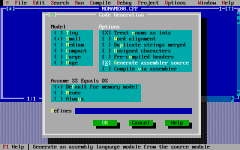Frenkel
Member
- Joined
- Jan 1, 2022
- Messages
- 46
Wanna have a laugh? Watch deatsaw run Doom on a real 286.
Doom8088 is a port of Doom for 16-bit PCs based on GBADoom.
Right now, it's only a proof of concept. It supports only Doom 1 Episode 1. There's no support for sound, music, multiplayer, mouse or PWADs. Demos are out of sync and there are lots of crashes due to memory issues. To decrease memory usage, only one texture is used for every wall.
GBADoom needs only 256 kB of RAM. A PC can have 640 kB of RAM. That's more than enough to run Doom, right? Well, in contrast to a Game Boy Advance, on a PC the code, graphics and level data all use that 640 kB. To make it fit, for every rendered frame, every image is loaded from the hard disk into memory and after it is used, it is immediately freed to make room for the next image. The lookup tables for sine, cosine etc. are stored on disk, so for every calculation a file on the hard disk is read. (Maybe using a RAM drive could speed this up?)
Doom8088 is a port of Doom for 16-bit PCs based on GBADoom.
Right now, it's only a proof of concept. It supports only Doom 1 Episode 1. There's no support for sound, music, multiplayer, mouse or PWADs. Demos are out of sync and there are lots of crashes due to memory issues. To decrease memory usage, only one texture is used for every wall.
GBADoom needs only 256 kB of RAM. A PC can have 640 kB of RAM. That's more than enough to run Doom, right? Well, in contrast to a Game Boy Advance, on a PC the code, graphics and level data all use that 640 kB. To make it fit, for every rendered frame, every image is loaded from the hard disk into memory and after it is used, it is immediately freed to make room for the next image. The lookup tables for sine, cosine etc. are stored on disk, so for every calculation a file on the hard disk is read. (Maybe using a RAM drive could speed this up?)

